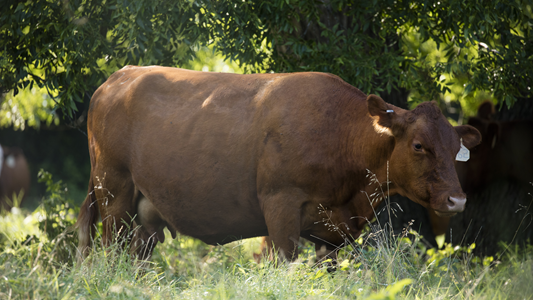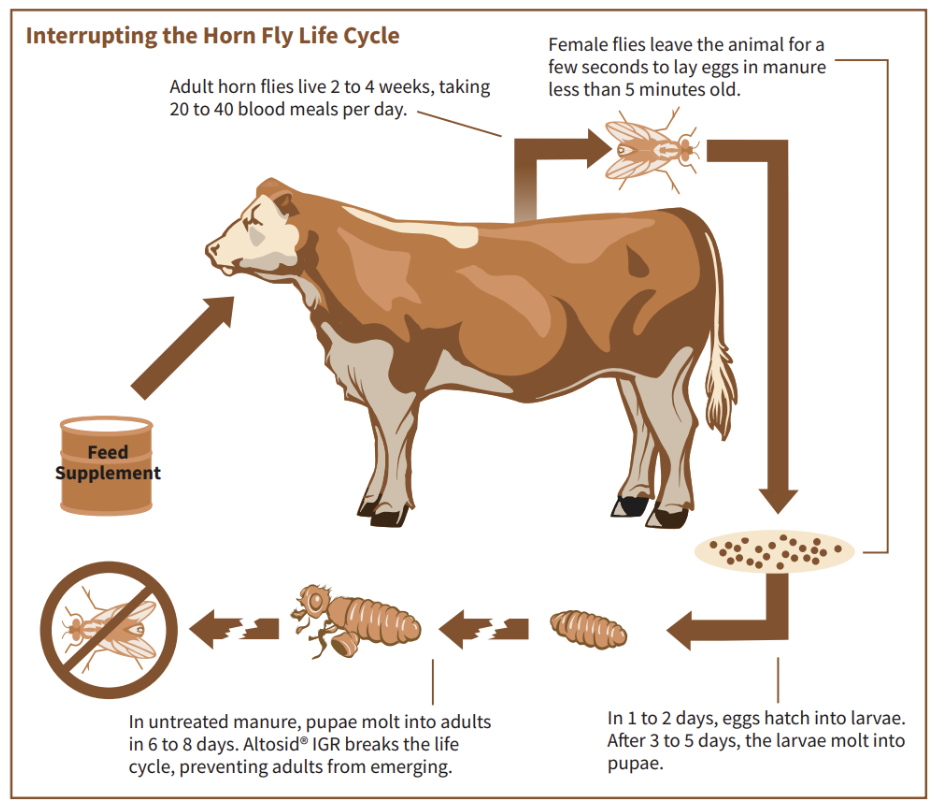Horn flies, a pervasive pest in the cattle industry, are small biting insects that pose significant challenges for cattle producers. This blog will dive into the biology of horn flies, their economic impact, infestation thresholds, and the methods available for their control.
Introduction to Horn Flies: Description and Behavior
Horn flies (Haematobia irritans) are tiny biting flies, roughly half the size of house flies, characterized by their gray coloring and two distinctive stripes on the thorax. These pests are equipped with piercing mouthparts, enabling them to take up to 40 blood meals a day. This constant feeding behavior leads to significant discomfort and health issues for cattle, costing the North American cattle industry a staggering $1.5 billion annually.
Female horn flies are known for their specific reproductive behavior—they only leave their bovine hosts to lay eggs in freshly deposited cow manure. Typically found congregating on the backs of cattle, these flies cause reduced weight gain in beef cattle and negatively impact overall productivity.
Economic Impact: Costs and Productivity Losses
Horn flies are among the most economically damaging pests for range cattle in the United States. The economic impact horn flies leave, extend beyond the immediate costs of control measures; it includes significant productivity losses. The North American cattle industry loses over $1 billion per year due to these pests.
The economic losses stem from several factors:
- Reduced Weight Gains: Horn flies cause stress and irritation, leading to decreased feed efficiency and reduced weight gains in cattle.
- Decreased Milk Yields: Blood loss and excessive energy expenditure to dislodge flies can reduce milk production.
- Energy Balance Disruption: The total energy balance of cattle is altered when exposed to a horn fly infestation, further contributing to decreased productivity.
Thresholds for Control and Infestation Levels
Effective management of horn fly populations involves understanding the economic threshold for infestations. This threshold is defined as the number of horn flies per animal at which the damage caused equals the cost of control measures. Studies have shown that the generally accepted economic threshold is 200 flies per animal. When horn fly counts reach this level, it becomes economically advantageous to implement control strategies.
Control methods should aim to maintain horn fly populations well below this threshold to ensure optimal cattle performance and productivity.

Current Control Methods: Mechanical, Biological, and Chemical
Various horn fly control methods are employed to handle fly populations, including mechanical, biological, and chemical methods.
Mechanical Control
- Walk-through Fly Traps: These traps can physically remove horn flies from cattle.
- Pasture Management: Dragging pastures to disrupt manure pats can reduce horn fly breeding sites.
Biological Control
- Predatory Arthropods: Beetles and mites can naturally reduce horn fly populations by preying on them or their larvae.
Chemical Control
Chemical control remains the most widely used method for managing horn fly infestations. Insecticides can be administered in several ways:
- Oral Larvicides: These are included in mineral granules, blocks, tubs, or controlled-release boluses.
- Ear Tags: Introduced in the late 1970s, ear tags impregnated with insecticides have been widely used. However, resistance to pyrethroids (a common chemical in ear tags) has developed rapidly.
One of the significant challenges with chemical control is the development of resistance. Continuous exposure to a single class of insecticides can lead to flies developing tolerance, rendering the insecticides ineffective. However, new solutions like Altosid® IGR, which contains the insect growth regulator (IGR) (S)-Methoprene, have proven effective. This IGR disrupts the horn fly's life cycle by inhibiting the development of immature flies into biting adults. Since its introduction in 1975, there have been no verified cases of resistance to (S)-Methoprene.
Horn flies pose a significant threat to cattle productivity and the economic viability of cattle operations. Understanding the biology, economic impact, and effective horn fly control methods is crucial for managing these pests. By employing a combination of mechanical, biological, and chemical strategies, cattle producers can effectively reduce horn fly populations, enhance cattle health, and improve productivity.


